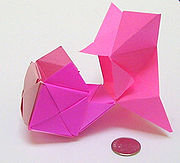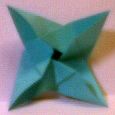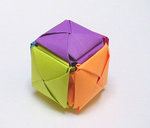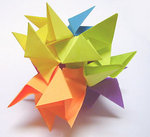
Tamatebako
Encyclopedia

Origami
is the traditional Japanese art of paper folding, which started in the 17th century AD at the latest and was popularized outside Japan in the mid-1900s. It has since then evolved into a modern art form...
model featured in a Japanese folk tale. It is a modular cube design that can be opened from any side. If more than one face of the model is opened, the cube falls apart and cannot easily be reconstructed. The model, and the directions for creating it, had been lost for centuries and only recently rediscovered.
Drawings from a three volume set of wood carvings, "Ranma-Zushiki" (Ranma Sketches) published in 1743 by Hayato Ohoka, featured a colored origami cube. In 1993, Yasuo Koyanagi identified the cube as the Tamatebako, and the model was published in the book "Koten-ni-miri-origami" by Satoshi Tagaki. The popular origami historian, Masao Okamura then was able to reconstruct the model, and by comparison to other traditional works, verify the model's authenticity.
Urashima Taro and the Tamatebako
The Tamatebako appears in the story "Urashima TaroUrashima Taro
is a Japanese legend about a fisherman who rescues a turtle and is rewarded for this with a visit to Ryūgū-jō, the palace of Ryūjin, the Dragon God, under the sea...
", where the fisherman was invited to the enchanted palace
Ryugu-jo
In Japanese mythology, Ryūgū-jō is the undersea palace of Ryūjin, the dragon god of the sea. Depending on the version of the legend, it is built from red and white coral, or from solid crystal. The inhabitants of the palace were Ryūjin's servants, which were various denizens of the sea...
of Otohime, who is the Mistress of the Sea, after saving a turtle. Urashima Taro went, ate at a big feast, watched the fish dance, and enjoyed the enchanted land for three days. Eventually he began to miss his home land.
So he asked Otohime to send him back home, which she was happy to do. As a parting gift, she gave him the Tamatebako with explicit instructions to never open the box. He went back home, but to his dismay, all that he once knew had changed. He did not recognize the people, the buildings, or anything at all. He came across an old man, and asked him if he had ever heard of Urashima Taro. The man replied that he had heard of him, that he had gone to the sea 300 years ago and never returned.
With time he grew very depressed, and decided to see what was in the box. When he opened the box, a white puff of smoke escaped, and he was transformed into an old, white haired man. The time that had passed while he was at the palace was great, and Otohime had stored his old age away in the Tamatebako, which Urashima Taro released.
A Tamatebako is enshrined in the Urashima Jinja in the Tango Peninsula in northern Kyoto Prefecture
Kyoto Prefecture
is a prefecture of Japan located in the Kansai region of the island of Honshu. The capital is the city of Kyoto.- History :Until the Meiji Restoration, the area of Kyoto prefecture was known as Yamashiro....
.
Basic folding instructions

Pinwheel
Pinwheel may refer to:* Pinwheel , a children's show on Nickelodeon that ran from 1977-1990.** Pinwheel , a channel which would later be the Nickelodeon channel...
-fold the outer edges, and fold the protruding pinwheel flaps inward, interleaving them to produce a multilayered square with the top woven together. Fold outward the triangular flaps cut from the center square. This creates one face of the cube; the entire cube requires six identical modules.

Variations

A more elaborate traditional version of the Tamatebako can be made in the form of a cuboctahedron
Cuboctahedron
In geometry, a cuboctahedron is a polyhedron with eight triangular faces and six square faces. A cuboctahedron has 12 identical vertices, with two triangles and two squares meeting at each, and 24 identical edges, each separating a triangle from a square. As such it is a quasiregular polyhedron,...
, still using six square pinwheel faces as described above. All four of the cut center flaps from each pinwheel square are extended outward; each of the eight new faces is formed by overlapping one flap each from three adjacent faces to form an equilateral triangle. Originally, the overlapped triangle was glued together, although it is possible to construct a triangular face hinge that does not require glue.
The folding pattern for this form was documented by Isao Honda in 1933 alongside the simple cube. It was also documented by Harry Houdini
Harry Houdini
Harry Houdini was a Hungarian-born American magician and escapologist, stunt performer, actor and film producer noted for his sensational escape acts...
as a "Japanese hexagon puzzle box" in 1922 without the simple cube version, in the company of several other traditional models which he learned from a Japanese acquaintance. Like the cube, this form can also be opened from any of the six square faces by unfolding each pinwheel, but will not fall apart if assembled with glue.
External links
Further reading
- Ranma-Zushiki, Hayato Ohoka, 1734
- Houdini's Paper Magic, Harry Houdini, 1922
- Koten-ni-miri-origami, Satoshi Tagaki, 1993
- Extreme Origami, Kunihiko KasaharaKunihiko Kasaharais a Japanese origami master. He has made hundreds of models, from simple lion masks to complex modular origami, such as a small stellated dodecahedron. He does not specialize in what is known as "super complex origami", but rather he likes making simple, elegant animals, and modular designs such...
, 2001, ISBN 0-8069-8853-3 - The Art and Wonder of Origami, Kunihiko KasaharaKunihiko Kasaharais a Japanese origami master. He has made hundreds of models, from simple lion masks to complex modular origami, such as a small stellated dodecahedron. He does not specialize in what is known as "super complex origami", but rather he likes making simple, elegant animals, and modular designs such...
, 2004, ISBN 978-1-59253-213-1

